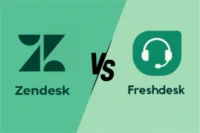Blockchain vs Traditional Databases: A Detailed Comparison
Published: 22 Feb 2025
In the world of data management, two technologies have emerged as key players: blockchain and traditional databases. While both are designed to store and manage data, they differ significantly in their architecture, functionality, and use cases.

This article provides a detailed comparison of blockchain and traditional databases, highlighting their strengths, weaknesses, and ideal applications. Additionally, a quick comparison table is included for easy reference.
What is a Traditional Database?
A traditional database is a centralized system that stores and manages structured data. It uses a client-server architecture, where a central authority (the server) controls access to the data. Users (clients) can read, write, update, or delete data based on permissions granted by the server. Examples of traditional databases include MySQL, PostgreSQL, and Oracle.
Key Features of Traditional Databases:
- Centralized Control: A single entity manages the database, ensuring consistency and control.
- CRUD Operations: Supports Create, Read, Update, and Delete operations.
- High Performance: Optimized for fast data retrieval and processing.
- Scalability: Can handle large volumes of data and users with proper infrastructure.
- ACID Compliance: Ensures data integrity through Atomicity, Consistency, Isolation, and Durability.
What is Blockchain?
Blockchain is a decentralized, distributed ledger technology that records transactions across a network of computers. Each transaction is grouped into a “block” and linked to the previous block, forming a chain. This structure ensures transparency, immutability, and security. Blockchain is best known for powering cryptocurrencies like Bitcoin and Ethereum, but its applications extend far beyond finance.
Key Features of Blockchain:
- Decentralization: No single entity controls the data; it is distributed across multiple nodes.
- Immutability: Once data is recorded, it cannot be altered or deleted.
- Transparency: All participants in the network can view the data.
- Security: Cryptographic techniques ensure data integrity and prevent tampering.
- Consensus Mechanisms: Transactions are validated through consensus algorithms like Proof of Work (PoW) or Proof of Stake (PoS).
Quick Comparison Table of blockchain vs traditional databases
| Feature | Traditional Databases | Blockchain |
| Control | Centralized | Decentralized |
| Data Integrity | Mutable (CRUD operations) | Immutable |
| Performance | High-speed transactions | Slower due to consensus mechanisms |
| Scalability | Highly scalable | Limited scalability |
| Security | Relies on access controls | Cryptographic and decentralized |
| Cost | Lower operational costs | Higher operational costs |
| Use Cases | E-commerce, banking, inventory | Supply chain, voting, cryptocurrency |
Blockchain vs Traditional Databases: Key Comparison
Here’s a breakdown to help you to understand all the differences between Blockchain and Traditional Databases:
1. Control and Governance
Traditional Databases: Traditional databases operate under a centralized control model, where a single entity or authority manages the database. This centralization simplifies management, as updates, maintenance, and access control are handled by a single administrator.
However, this also creates a single point of failure. If the central server is compromised or experiences downtime, the entire system can become inaccessible or vulnerable to attacks.
Blockchain: Blockchain, on the other hand, is decentralized. It operates on a distributed network of nodes, where no single entity has control over the entire system. This eliminates single points of failure, making the system more resilient to outages and attacks.
However, governance becomes more complex because any changes or updates to the blockchain require consensus among the participants in the network. This can slow down decision-making and implementation processes.
2. Data Integrity
Traditional Databases: In traditional databases, data can be modified, updated, or deleted using CRUD (Create, Read, Update, Delete) operations. This flexibility is useful for correcting errors, updating records, and maintaining data accuracy. However, it also poses a risk of tampering or unauthorized changes, especially if the database is not properly secured.
Blockchain: Blockchain ensures immutability, meaning once data is recorded in a block and added to the chain, it cannot be altered or deleted. This immutability ensures trust and transparency, as all participants can verify the integrity of the data.
However, this also makes it difficult to correct errors or update information, as any changes would require creating a new transaction and achieving consensus across the network.
3. Performance
Traditional Databases: Traditional databases are optimized for high-speed transactions and large-scale data processing. They can handle thousands of transactions per second (TPS) and are designed to support real-time applications like e-commerce, banking, and inventory management. Their performance is further enhanced by indexing, caching, and other optimization techniques.

Blockchain: Blockchain is generally slower compared to traditional databases due to its consensus mechanisms (e.g., Proof of Work or Proof of Stake) and cryptographic processes. These mechanisms ensure security and decentralization but add latency to transaction processing.
For example, Bitcoin processes around 7 TPS, while Ethereum handles about 30 TPS. This makes blockchain less suitable for applications requiring high-frequency transactions.
4. Scalability
Traditional Databases: Traditional databases are highly scalable, both vertically (adding more resources to a single server) and horizontally (distributing data across multiple servers). With proper infrastructure and optimization, they can handle massive amounts of data and users, making them ideal for large-scale applications like social media platforms and enterprise systems.
Blockchain: Blockchain faces scalability challenges due to its decentralized nature. Every transaction must be validated and replicated across all nodes in the network, which increases the time and resources required for processing.
While solutions like sharding and layer-2 protocols (e.g., Lightning Network) are being developed to improve scalability, blockchain still lags behind traditional databases in this regard.
5. Security
Traditional Databases: Traditional databases rely on firewalls, encryption, and access controls to secure data. While these measures are effective, they are not foolproof. Centralized systems are vulnerable to cyberattacks, insider threats, and data breaches, especially if security protocols are not rigorously enforced.
Blockchain: Blockchain is inherently more secure due to its decentralized architecture and cryptographic techniques. Each block is linked to the previous one using cryptographic hashes, making it nearly impossible to alter data without detection.
Additionally, consensus mechanisms ensure that malicious actors cannot easily manipulate the system. However, blockchain is not entirely immune to attacks, such as 51% attacks or vulnerabilities in smart contracts.
6. Cost
Traditional Databases: Traditional databases have lower operational costs for small to medium-sized applications. They require less computational power and energy, and their centralized nature simplifies maintenance and management. However, costs can increase significantly for large-scale systems requiring high availability and redundancy.
Blockchain: Blockchain is more expensive to operate due to its computational intensity and energy consumption. For example, Proof of Work (PoW) blockchains like Bitcoin require significant energy for mining.
Additionally, maintaining a distributed network of nodes and ensuring consensus adds to the operational costs. These factors make blockchain less cost-effective for applications that do not require its unique features.
7. Use Cases
Traditional Databases: Traditional databases are ideal for applications that require fast data processing, frequent updates, and high scalability. Common use cases include:
- E-commerce platforms: Handling real-time transactions and inventory management.
- Banking systems: Processing large volumes of financial transactions.
- Inventory management: Tracking and updating product data in real time.
- Social media platforms: Managing user data and interactions at scale.

Blockchain: Blockchain is best suited for applications that require transparency, trust, and immutability. Common use cases include:
- Supply chain management: Tracking the movement of goods and ensuring authenticity.
- Voting systems: Ensuring secure and tamper-proof elections.
- Cryptocurrency: Facilitating decentralized financial transactions.
- Healthcare: Securely storing and sharing patient records.
- Smart contracts: Automating and enforcing agreements without intermediaries.
When Blockchain Is Better:
- Transparency and Trust: If your application requires transparency and immutability (e.g., supply chain tracking, voting systems, or cryptocurrency), blockchain is the better option.
- Decentralization: If you want to eliminate single points of failure and central authority (e.g., peer-to-peer transactions or decentralized applications), blockchain is ideal.
- Security: If data integrity and tamper-proof records are critical (e.g., healthcare records or legal contracts), blockchain provides superior security.
- Auditability: If you need a verifiable and permanent record of transactions, blockchain ensures traceability and accountability.
When Traditional Databases Are Better:
- High-Speed Transactions: If your application requires fast data processing (e.g., e-commerce, banking, or real-time analytics), traditional databases are the better choice.
- Frequent Data Updates: If you need to frequently modify or delete data (e.g., inventory management or customer records), traditional databases offer more flexibility.
- Cost-Effectiveness: For small to medium-sized applications, traditional databases are more affordable and easier to maintain.
- Scalability: If you need to handle large volumes of data and users, traditional databases are highly scalable with proper infrastructure.
Conclusion
The choice between blockchain and traditional databases depends on the specific needs of the application. Traditional databases are better suited for scenarios requiring high performance, scalability, and cost-efficiency, while blockchain excels in applications where transparency, security, and decentralization are critical.
By understanding the strengths and limitations of each technology, businesses and developers can make informed decisions to optimize their data management strategies.
FAQs about Blockchain vs Traditional Databases
Here are some of the most FAQs related to Blockchain vs Traditional Databases:
Blockchain is decentralized and immutable, ensuring transparency and security, while traditional databases are centralized, allowing for easy updates and high-speed transactions.
Blockchain uses cryptographic techniques and decentralization, making it resistant to tampering and hacking, whereas traditional databases rely on firewalls and access controls, which can be breached.
No, data in a blockchain is immutable, meaning it cannot be altered or deleted once recorded, ensuring trust and transparency.
Traditional databases are optimized for high-speed transactions and use indexing and caching, while blockchain is slower due to consensus mechanisms and cryptographic processes.
Blockchain requires consensus and data replication across all nodes, which increases processing time and resource usage, making it less scalable than traditional databases.
Traditional databases are more cost-effective for small to medium-sized applications, while blockchain has higher operational costs due to energy consumption and network maintenance.
Traditional databases are ideal for e-commerce, banking, inventory management, and social media platforms, where fast data processing and scalability are critical.
Blockchain is best suited for supply chain management, voting systems, cryptocurrency, healthcare records, and smart contracts, where transparency and immutability are essential.
Blockchain is unlikely to replace traditional databases entirely, as it is better suited for specific use cases requiring decentralization and trust, while traditional databases excel in performance and scalability.
Blockchain’s decentralized nature requires consensus for updates, making governance more complex compared to traditional databases, which are centrally controlled and easier to manage.

- Be Respectful
- Stay Relevant
- Stay Positive
- True Feedback
- Encourage Discussion
- Avoid Spamming
- No Fake News
- Don't Copy-Paste
- No Personal Attacks

- Be Respectful
- Stay Relevant
- Stay Positive
- True Feedback
- Encourage Discussion
- Avoid Spamming
- No Fake News
- Don't Copy-Paste
- No Personal Attacks





